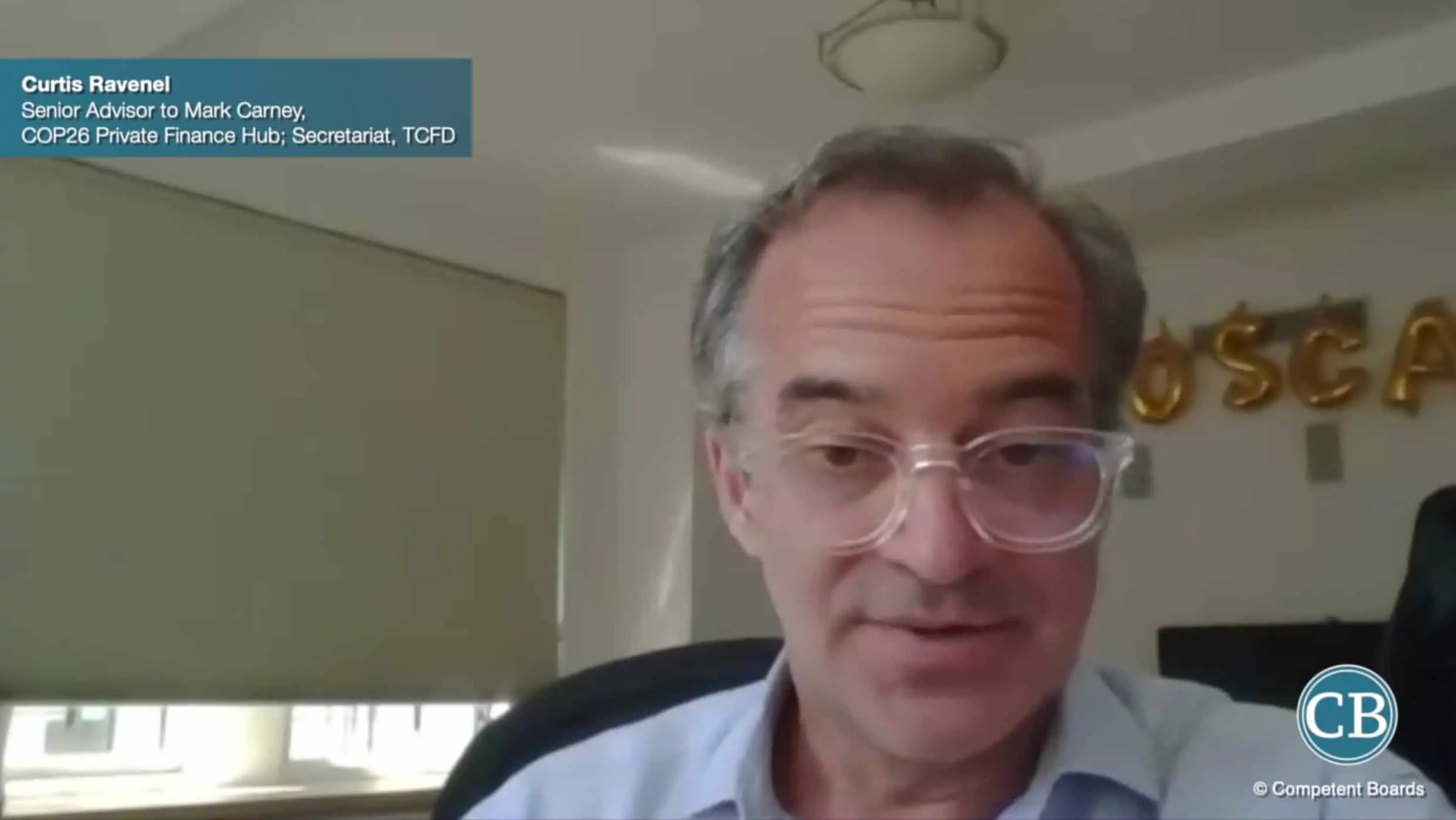
As we transition to a net-zero future, board members are facing more pressure to act competently on climate issues. Below, our CEO & Founder Helle Bank Jorgensen discusses with Curtis Ravenel, Senior Advisor to Mark Carney, COP26 Private Finance Hub and Secretariat, TCFD, where boards can start on climate action and what he hopes to see at the upcoming COP26.
Helle Bank Jorgensen: When you think about Shell, you have many people–investors, activists, youth activists, and societal activists alike–that went to the government and got this ruling that Shell isn’t doing enough to combat climate change. Now, you’re a board member thinking about these things–Shell, Exxon losing board seats to activists, TCFD, the upcoming COP26, net-zero targets by 2030, 2050, etc.–where would you start?
Curtis Ravenel: With what we saw with Exxon losing board seats to activist investors, the call to update boards to include climate professionals and transition planning experts is an important point to make. I did not expect the voting to go that way, so you can’t understate the importance of this event. My view is there will be a trend of more integrated, diversified energy companies.
That said, I may be a little biased here, but I would start with TCFD. We expect to publish a TCFD consultation in the fall before COP26 to update metrics, targets, strategy sections; implement guidelines; and incorporate concepts of transition planning to reflect the very fast-moving field that is climate. I think the best advice is, in order to respond to all of those things that you brought up, you need a foundational understanding of where you are today with regard to exposure. We can see where the climate debate is headed based on evidence. Ask yourself, do we, as an organization, have the institutional capacity to respond to this fast-moving field? We have heard time and time again from companies that have used the TCFD to inform their disclosure or are in the process of answering the questions posed by the TCFD, that there have been incredible opportunities and learning experiences to connect different pieces of the business that sometimes don’t connect historically.
Helle Bank Jorgensen: All these different forces, is this something happening in the next two, three years? Is this happening now or tomorrow? Think COP26. What are you hoping will come out of that?
Curtis Ravenel: Different actors–private, non-state, cities, states, companies, and various other players–are now in this “race to zero” where all of these bodies are trying to commit to net-zero by 2050. They’ve created a number of vehicles under which the commitment can be validated, like new reports. So the goal, at least in part, is to create headroom, show ambition from the private sector, and fortify the policymakers’ ambition and so forth. And you hopefully have continual development.
So what I expect to see if you’re a board member, is you’re going to get a lot of pressure, whether you’re in finance or not, from a number of different entities to make net-zero commitments. But my advice is to make credible ones that include transition plans and are based on science. The “race to zero” campaign will be a mad rush between now and COP to get as many people on this train as possible. And it will go on through 2050 as a permanent initiative within that COP process. What you’ll see is a hardening of those net-zero expectations over the next several years. In some cases, we’ll actually see jurisdictions not only make pledges to cut emissions like the US has, but actually legislate to cut emissions as we’ve seen with the EU.
Helle Bank Jorgensen: Any last thoughts, advice or must-do’s?
Curtis Ravenel: I think a lot of companies see all of this as a burden. It’s a fascinating issue where one side of the coin is risks; the other side is opportunity. This will take a massive shift of capital, and capital allocation is going to change. How do we support that? How, as a firm, do we take and seize that opportunity? I think climate is too often talked about as a risk and that the opportunity side is not as highly discussed. I really think that this exercise of identifying your risk is also just as much of an opportunity to say, how do I mitigate that risk? It’s not just about managing the risk. It’s also about creating a diversified portfolio of business opportunities that help you do that.
The above is an excerpt of the Fireside Chat interview with Curtis Ravenel. Participants in the ESG Competent Boards Certificate and Designation program have access to the full interview, among many others. For more insights on important ESG topics, learn more about our certificate programs here, including our new Climate Competent Boards Certificate Program, presented in partnership with Arizona State University’s Julie Ann Wrigley Global Futures Laboratory, University of Oxford Saïd Business School, and Thunderbird School of Global Management.
Back To News & Views